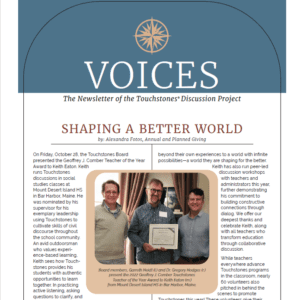By Alexandra Fotos
Linnea and George Takacs have been involved with Touchstones for many years and recently decided to seal their commitment by including Touchstones Discussion Project in their estate plans. On September 8, I interviewed Linnea Takacs to learn what brought her and George to Touchstones and ultimately to make a gift for the future to ensure Touchstones continues its work.
First, tell me a little about yourselves.
Our careers have been in education. George received his Ph.D. in Educational Administration at the University of Connecticut in 1971. I was a stay-at-home mother and completed my own education in 1988, culminating with a Ph.D. in English from Fordham. I also taught there, including in a summer bridge program called Higher Education Opportunity Programs, for incoming freshmen. For most of George’s career, he was running International Schools in South and Central America. Our longest stint was 11 years in Chile. When we were in Quito, Ecuador, I chaired the English department at a university and developed the libraries in his schools in Chile and Brazil.
How and when did you learn about Touchstones?
Our daughter, Stef, was a student at St. John’s College in Annapolis from the mid to the late 1980’s. One of her tutors and a co-founder, Geoffrey Comber, told her about Touchstones. We were living in Venezuela and Geoff had some correspondence with George, but it didn’t lead to anything then. A number of years later, when George was running the American school in Recife, Brazil, he was finally able to bring Touchstones into the curriculum. That’s when we really started to learn about Touchstones.
What was your first impression?
We were excited from the beginning to know the founders created Touchstones from nothing and we’re still amazed at its evolution into so many different programs and areas and its potential for growth.
Is there a particular program you are drawn to?
The programs designed for schoolchildren of all grades, especially Touchpebbles. It’s exciting to see young children’s thinking stimulated. We also like the Veterans Program because of what could be possible for veterans using Touchstones—what it really means for them to come home. And I know that teachers, donors, and volunteers in the current Saturday discussions online find that program very beneficial and supportive.
What inspired you and George to leave a planned gift to Touchstones?
Educators. They are the people who want to be involved in Touchstones and this gift will support their access to the programs—even when there’s no public funding for education. Making Touchstones accessible to educators helps ensure its implementation and success in the future. We decided to designate our gift to teacher scholarships for workshops and free Touchstones materials for their classes after they complete the workshops. This gift is specifically to benefit and empower teachers who want to use Touchstones and Touchpebbles in their teaching but have limited funding.
What words would you share with our readers about making a planned gift to Touchstones?
If one has any resources, there can’t be a better cause that reaches so many different areas of daily life. Touchstones educates in so many ways that go beyond traditional academic boundaries. It provides a framework where one can develop their interpersonal skills and better understand how best to communicate and listen.



 Join the
Join the